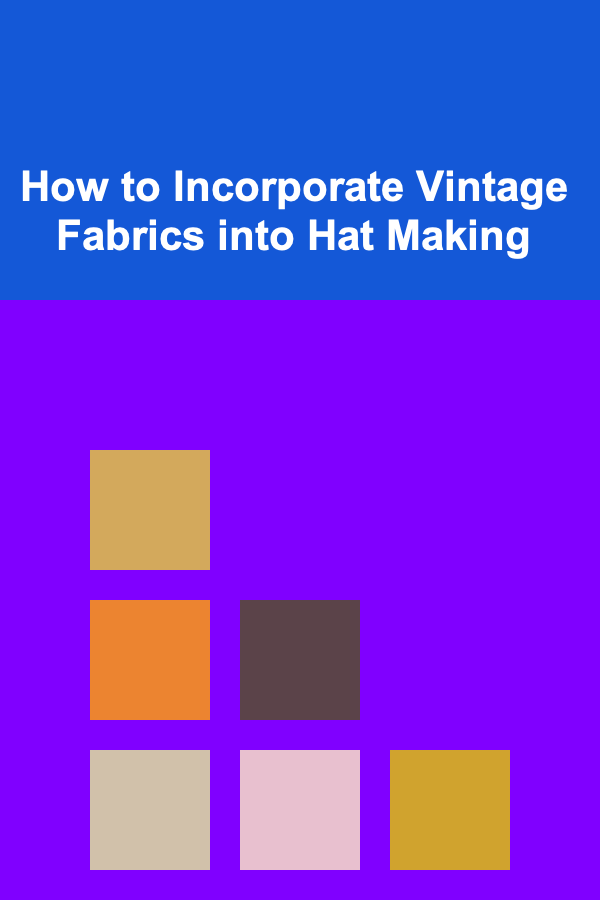
How to Incorporate Vintage Fabrics into Hat Making
ebook include PDF & Audio bundle (Micro Guide)
$12.99$11.99
Limited Time Offer! Order within the next:

Creating hats is an art that requires a deep understanding of fabric selection, structure, and style. Vintage fabrics add an intriguing layer of history, texture, and elegance to modern hat-making. When you incorporate these fabrics into your designs, you're not just creating a stylish piece of headwear---you're also weaving a story into every stitch. This article delves into how to effectively incorporate vintage fabrics into hat making, including choosing the right fabrics, understanding their unique characteristics, and learning how to work with them to achieve the desired effect.
Why Choose Vintage Fabrics?
Vintage fabrics carry with them a sense of nostalgia and uniqueness. These materials often feature exquisite prints, rare textures, and long-lasting durability, making them an excellent choice for crafting one-of-a-kind hats. Whether you're drawn to the charm of mid-century prints, the elegance of Victorian lace, or the richness of 1920s velvet, vintage fabrics offer something for every hat maker.
Choosing vintage materials also speaks to sustainability. Using upcycled fabrics helps reduce waste and gives a new life to old textiles, aligning with modern eco-friendly practices.
Types of Vintage Fabrics Ideal for Hat Making
Before diving into the process, it's essential to understand the types of vintage fabrics that work well for hat-making. Not all vintage materials are suitable for this craft, so you need to pick those that will hold their shape and offer longevity.
1. Vintage Velvet
Velvet is a luxurious fabric known for its soft texture and deep color. Vintage velvet, especially from the 1920s and 1930s, can add a touch of glamour and elegance to any hat. Whether you are making a cloche or a fascinator, vintage velvet can bring depth and a tactile richness to your design. The fabric's ability to hold its shape makes it an excellent choice for structured hats.
- Use in: Cloche hats, pillboxes, headbands, and evening hats.
- Caring for vintage velvet: Velvet is delicate, so be cautious with cleaning. Spot clean whenever possible, or dry clean if necessary.
2. Vintage Silk
Silk is a versatile and timeless fabric used throughout history, from the Victorian era to the 1950s. Vintage silk fabrics are often more delicate than modern silks, but they offer an incomparable sheen and softness. Vintage silk satin, silk taffeta, and silk chiffon can all be used to create lightweight, elegant hats with an air of sophistication.
- Use in: Fascinators, wide-brimmed hats, and lightweight summer hats.
- Caring for vintage silk: Handle with care, and avoid exposure to direct sunlight, which can cause fading.
3. Vintage Wool
Wool has been a go-to fabric for hat-making for centuries, especially in colder climates. Vintage wool materials often feature patterns and textures that you won't find in modern fabrics. Wool felt, for example, is an excellent choice for structured hats like fedoras or berets, providing both warmth and durability.
- Use in: Fedoras, berets, winter hats, and cloches.
- Caring for vintage wool: Wool requires gentle cleaning to prevent shrinking or felting. Dry clean whenever possible, and avoid washing by hand unless you're experienced.
4. Vintage Lace and Brocade
Lace and brocade fabrics, often found in antique bridal veils or garments, add an intricate touch to any hat. These fabrics are typically more delicate and can be used to create delicate trimmings, overlays, or even complete hat structures for more formal or vintage-inspired designs.
- Use in: Bridal hats, headbands, and period-specific hats like those from the 18th century.
- Caring for vintage lace and brocade: Lace and brocade require careful storage and gentle cleaning. Hand wash or dry clean as needed.
5. Vintage Cotton Prints
Vintage cotton fabrics, particularly those from the 1950s or earlier, feature whimsical prints, florals, and checks that bring charm and character to a hat. This fabric is perfect for casual summer hats, beach bonnets, and playful creations. The ease with which cotton holds its shape makes it ideal for more informal or relaxed designs.
- Use in: Summer hats, sun hats, and casual daywear.
- Caring for vintage cotton: Cotton is easy to care for and can usually be machine washed, though vintage cotton may require gentler care to prevent wear and tear.
Understanding the Challenges of Working with Vintage Fabrics
While vintage fabrics are beautiful and distinctive, they come with their own set of challenges. Working with them requires patience and knowledge of how to handle delicate materials.
1. Fabric Integrity
Vintage fabrics, particularly those that are decades old, may show signs of wear, such as fading, fraying, or weakening of the fibers. This can affect the structure and longevity of the final hat. It's important to inspect each fabric carefully before use.
Solution: You can reinforce delicate areas by using stabilizers, underlining, or interfacing. Additionally, patchwork or layering can help mask imperfections in the fabric, allowing you to incorporate these materials while ensuring your hats maintain their integrity.
2. Pre-Treatment and Preservation
Vintage fabrics require careful pre-treatment to ensure they are clean and safe to use. Some materials may have age-related discoloration or damage that needs to be treated before use.
Solution: Gentle washing, dry cleaning, or steaming can help refresh the fabric. Always test a small, inconspicuous area first to avoid damaging the fabric.
3. Shape and Structure Challenges
Some vintage fabrics are less pliable than modern materials, making it harder to achieve a particular shape or structure. For example, vintage lace might be stiff and challenging to manipulate, while vintage silk may not hold its shape as easily.
Solution: Use hat-making tools such as hat blocks, steamers, or specific adhesives to help mold and shape the fabric. For silk or delicate fabrics, consider adding a light interfacing or using a soft hat base to help provide support.
How to Incorporate Vintage Fabrics into Hat Designs
Incorporating vintage fabrics into your hat designs requires careful thought about how to highlight the fabric's unique qualities while ensuring the hat is both stylish and functional. Here are several ways to incorporate vintage fabrics into your designs:
1. Create a Modern Twist on Classic Designs
If you're creating a vintage-inspired hat, combining modern styles with vintage fabrics can create a fresh, updated look. For example, use a vintage lace overlay on a contemporary felt fedora or add a vintage floral fabric to the band of a modern straw hat. This fusion of styles creates a dynamic, eye-catching design.
2. Experiment with Layering
Layering vintage fabrics is an excellent way to incorporate multiple textures and colors into one design. Try layering a vintage silk chiffon over a solid wool base or adding a vintage lace trim to a modern fabric hat. Layering can bring depth and visual interest to your creations, making them more unique and memorable.
3. Mix Different Periods and Styles
Vintage fabrics from different periods can be combined to create a look that's timeless yet original. For example, pairing 1920s velvet with 1970s floral cotton can create an eclectic, bohemian feel. Don't be afraid to mix styles and periods to create something that speaks to your personal aesthetic.
4. Use Vintage Fabrics for Details and Embellishments
If you're hesitant to use vintage fabric for the entire hat, you can incorporate it as a detail or embellishment. For instance, you might use vintage lace or brocade for a hat band or rosette. Vintage fabrics can also be used to make custom flowers, bows, or even small accessories that can be attached to a simple hat, giving it a touch of old-world charm.
5. Create Custom Hat Bands or Accents
A vintage fabric hat band can transform a simple hat into something extraordinary. Choose fabrics that complement the base of the hat---such as pairing a vintage floral cotton with a neutral-colored straw hat. Embellish the band with vintage buttons, brooches, or small fabric flowers to add extra detail and personality to the design.
Conclusion
Incorporating vintage fabrics into hat-making is a rewarding way to create one-of-a-kind pieces that blend history, craftsmanship, and style. By choosing the right fabrics, understanding their characteristics, and mastering the techniques to work with them, you can produce hats that are both visually striking and timeless. Whether you're drawn to the elegance of vintage velvet, the delicate charm of lace, or the bold patterns of 1950s cotton, vintage fabrics can add an unparalleled depth and story to your hat designs. So, embrace the beauty of these materials and start creating hats that tell a story from the past, all while being stylish and functional for today's world.
Reading More From Our Other Websites
- [Home Lighting 101] How to Illuminate Your Closet Like a Pro: A Guide to Closet Lighting Design and Installation
- [Organization Tip 101] How to Organize Travel Documents Before a Trip
- [Home Storage Solution 101] How to Unlock Hidden Potential: Genius Small Bedroom Storage Hacks for Every Corner
- [Home Pet Care 101] How to Set Up a Pet-Friendly Kitchen
- [Home Budget 101] How to Organize Your Finances for Better Home Budgeting
- [Hiking with Kids Tip 101] Kid-Safe Trails: Finding the Best Beginner Hikes Near You
- [Organization Tip 101] How to Create a Home Library That Inspires Reading
- [Personal Care Tips 101] How to Use Hand Cream for Extra Hydration After Exfoliating
- [Reading Habit Tip 101] From Page‑Turner to Bibliophile: How to Turn Casual Reading into a Passionate Hobby
- [Personal Care Tips 101] How to Use a Face Mask to Achieve Smooth, Radiant Skin

Generating Passive Income with Deep Learning: What You Need to Know
Read More
How to Create a Cozy Atmosphere with Budget Boho Decor
Read More
Web Content Manager's Handbook: Best Practices for SEO, Strategy, and Content Optimization
Read More
Unearthing Terroir: Identifying the Specificity of Single Vineyard Wines
Read More
How to Use Social Media for Market Research: A Deep Dive
Read More
10 Tips for Running a Faster 5K
Read MoreOther Products

Generating Passive Income with Deep Learning: What You Need to Know
Read More
How to Create a Cozy Atmosphere with Budget Boho Decor
Read More
Web Content Manager's Handbook: Best Practices for SEO, Strategy, and Content Optimization
Read More
Unearthing Terroir: Identifying the Specificity of Single Vineyard Wines
Read More
How to Use Social Media for Market Research: A Deep Dive
Read More